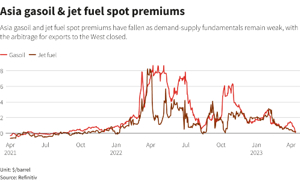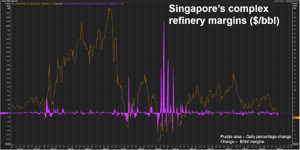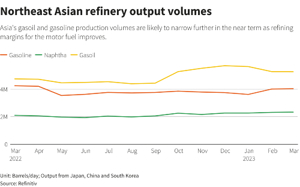Asian refiners to raise gasoline output, cut diesel to ease oversupply
(Reuters) - Several Asian refiners are likely to maximize gasoline output from May and reduce gasoil output, cashing in on higher profits for the motor fuel ahead of the peak summer driving season, industry sources and analysts say.
The adjustments come after margins for gasoil and jet fuel slumped on rising supplies as China boosted exports, while the arbitrage window to Europe has been shut since early 2023 due to ample supplies on the continent.
Meanwhile, gasoline profits have rebounded as traders build supplies ahead of a seasonal travel demand boost from April through September.
By adjusting production, the oversupplied gasoil market in Asia could tighten again and support prices.
At Taiwan's Formosa Petrochemical Corp, one of Asia's largest oil products exporters, the company plans to cut gasoil output from some units, such as the delayed coking unit, and ramp up gasoline production from its residue fluid catalytic cracker (RFCC), spokesman KY Lin told Reuters.
"Our gasoil production volumes will be down around 5%, with gasoline production yield up 2-3% for May compared with the original production plan," said Lin.
Refiners who can switch have been slowly making adjustments in the past few weeks, said a person working for a southeast Asia refinery who declined to be named due to company policy.
If the cracks continue to converge, there is a possibility of a production switch, a source at an Indian refinery said.
Complex refinery margins in Singapore, the bellwether for Asian refining margins, have more than halved to $3.17 a barrel - the lowest since October 2022 - from an average of $7.56 in March.
The extent to which Asian refiners can change production yields between light distillates - gasoline and naphtha - and middle distillates - gasoil and jet fuel - is limited on feedstock and catalyst reasons, estimated at between 3% and 5% on average, according to industry sources.
Still, refiners are eyeing strong demand from the United States, the world's top petrol guzzler, which is short on gasoline and blendstocks, traders said.
Even though U.S. refineries have ramped up output after first-quarter maintenance, imports are still required, one Singapore-based blendstock broker said.
More naphtha, petrochemicals
The rise in gasoline output is typically accompanied by more naphtha, which can be used as a blendstock for petrol or for the production of ethylene and propylene, used for plastics.
"Refiners considering ramping up their FCC runs would need to assess the overall uplift margins, as higher unit runs will produce more propylene, in addition to gasoline," said Serena Huang, head of Asia-Pacific analysis at data analytics firm Vortexa, adding that margins for propylene, a plastics raw material, are currently weak.
Northeast refiners, led by China, have boosted gasoil production since September to above 5 million bpd after margins for the 10-ppm product soared to a record $71.69 a barrel, Refinitiv data showed.
Gasoline output, on the other hand, rebounded to above 4 million bpd in January, the data showed.











Comments